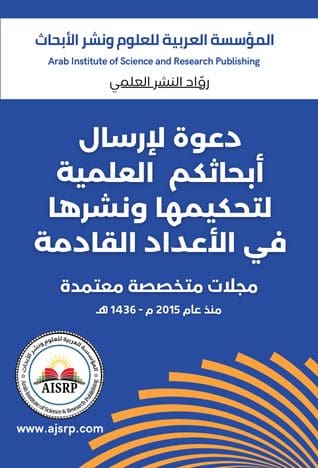THE EFFECT OF THE STRATEGIES OF GUIDED IMAGERY AND PROBLEM SOLVING
IN THE DEVELOPMENT OF CRITICAL THINKING SKILLS AMONG THE EIGHTH GRADE STUDENTS IN ISLAMIC EDUCATION IN JORDAN
Abstract:
This study aimed at uncovering the effect of using the strategies of guided imagery and problem solving in the development of critical thinking among the eighth grade students in the field of Islamic education at Madaba First Secondary School for Boys for the academic year 2017/2018.. In this study, the researcher followed the semi- experimental method.. To achieve the aim of the study, the researcher applied Watson & Glasser critical thinking test in its dimensions (Prediction, Hypothesis, Interpretation, Evaluation, Conclusion, and deduction). The control and experimental groups were randomly assigned to this school. Three classes of the eighth grade students were selected. Class (A) which consisted of (27) students studied in the strategies of guided imagery, class (b) which consisted of (25) students studied in the problem solving strategy, and class (c) which was the controlling group and consisted of 24 students studied in the usual manner.
The data were then collected and analyzed statistically. The results of the study revealed that there were statistically significant differences at the level of (α = 0.05) in the level of development of critical thinking skills. The group of guided imagery obtained an average of (10.52) (10.94). The control group obtained a total mean (7.18) and shows the difference in favor of the two experimental groups; this is due to the strategies of guided imagery and problem solving. The value of the ETA box for the total score (0.81) indicates a significant explanatory difference, and the absence of statistically significant differences at (α = 0.05) level in the development of critical thinking skills between the use of guided imagery and problem solving strategies in Islamic Education for the eighth grade . In light of the results, a number of recommendations and suggestions were presented to activate strategies for the development of critical thinking in teaching.
Keywords:strategy of guided imagery, problem solving strategy, critical thinking, Islamic education, eighth grade class
الملخص
ومن ثم جُمعت البيانات ثم حُللت إحصائياً، وقد كشفت نتائج الدراسة عن وجود فروق ذات دلالة إحصائية عند مستوى (α=0.05)في مستوى تنمية مهارات التفكير الناقد؛ حيث حصلت مجموعة التخيل الموجه على متوسط(10.52)، فيما حصلت مجموعة حل المشكلات على متوسط) 10.94) أما المجموعة الضابطة فحصلت على متوسط كلي(7.18)، ويظهر الفرق لصالح المجموعتين التجريبيتين؛ ويعزى إلى استراتيجية التخيل الموجه واستراتيجية حل المشكلات، كما بلغت قيمة مربع إيتا للدرجة الكلية (0.81) وهي تشير إلى تباين مفسر كبير، وعدم وجود فروق ذات دلالة إحصائية عند مستوى (α=0.05)في مستوى تنمية مهارات التفكير الناقد بين استخدام استراتيجيتي التخيل الموجه وحل المشكلات في مبحث التربية الإسلامية للصف الثامن الأساسي. وفي ضوء النتائج تم تقديم جملة من التوصيات والمقترحات لتفعيل استراتيجيات تنمية التفكير الناقد في التدريس.
الكلمات المفتاحية: استراتيجية التخيل الموجه، حل المشكلات، التفكير الناقد، مبحث التربية الإسلامية، الصف الثامن الأساسي
الباحث /
يوسف مفلح أبو الخيل
وزارة التربية والتعليم || الأردن



